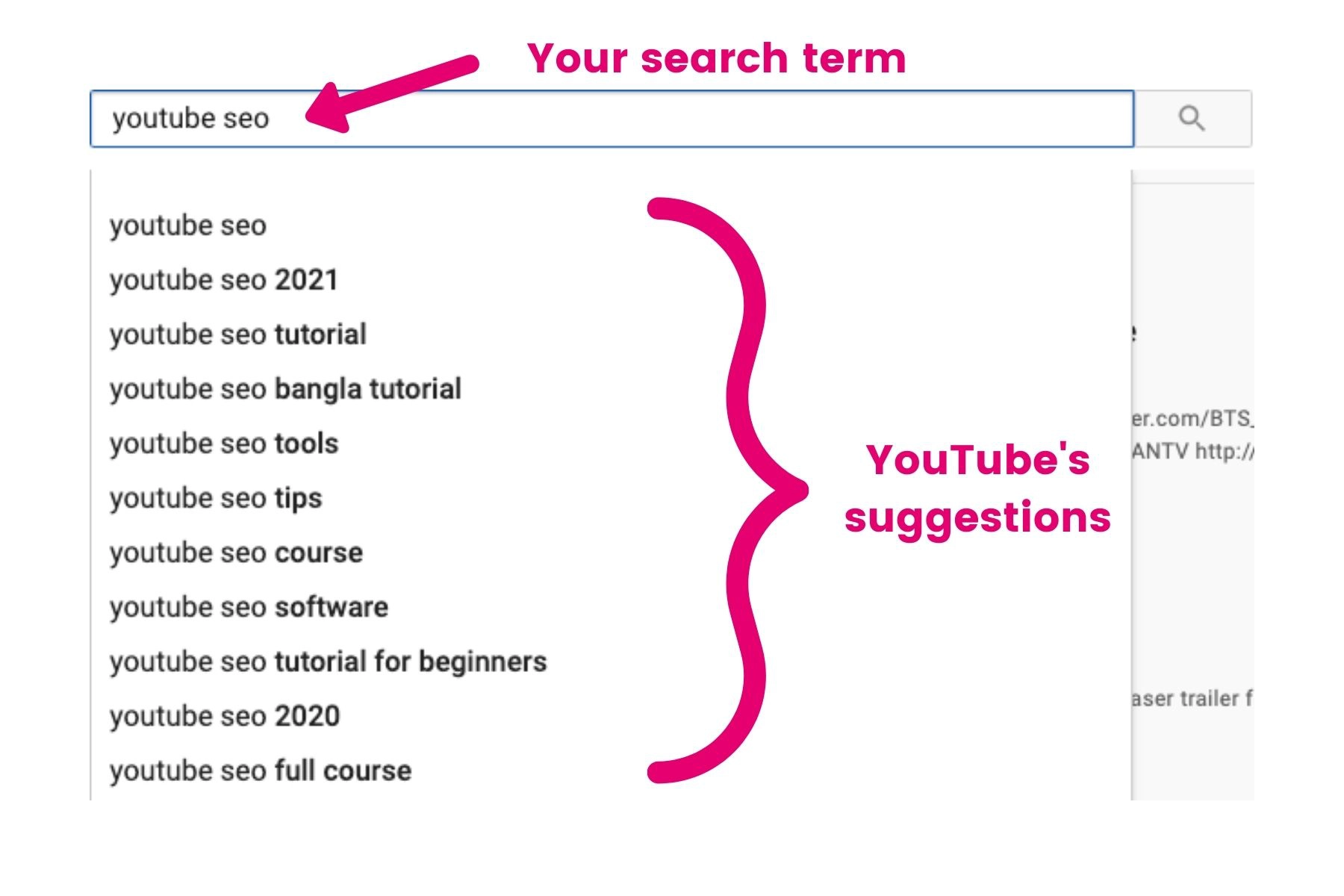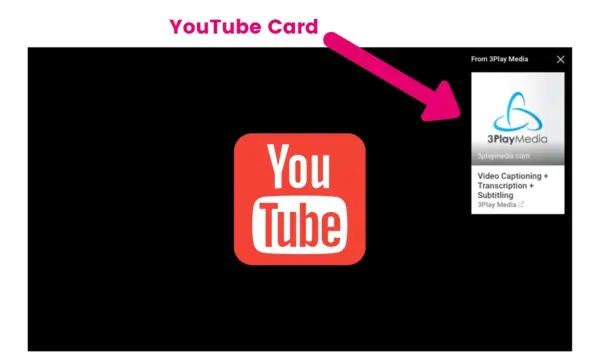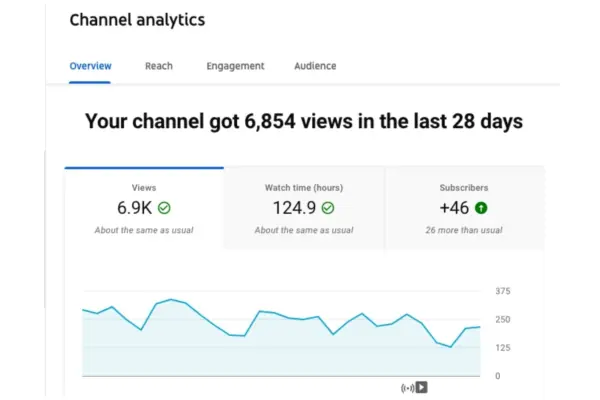
Google is the world’s second-largest search engine, behind its parent company, YouTube.
The most popular YouTube search term was “Kendall Jenner,” which accounted for eight out of 10 results. With over 500 hours of YouTube videos uploaded to YouTube every minute, the site is expanding at an exponential rate.
How can you navigate through the ocean of videos without getting lost? Using YouTube SEO best practices, you should try to improve excellent videos for search. With these ideas, you can create a strong YouTube SEO strategy.
Table of Contents
What is a YouTube SEO strategy?
The goal of Search Engine Optimization (SEO) is to improve your website’s search engine rankings by making it more appealing to search engines. The gatekeeper for your content is frequently searched, therefore optimizing your material for search is critical in order to attract traffic and develop a following.
YouTube SEO differs from Google’s approach in that it considers not only backlinks but also other elements to assess YouTube rankings. YouTube SEO entails improving your YouTube channel, playlists, metadata, descriptions, and videos, as well as optimizing your movies for search both on and off YouTube.
You may be familiar with the fundamentals of YouTube SEO, such as using keywords in titles, meta descriptions, and tags. However, there’s more you can do for YouTube SEO by making your videos more accessible.
Because search engine robots are unable to watch videos, they need text data to properly index them.
Transcriptions closed captions, and subtitles are important elements of a YouTube SEO strategy because they may improve user experience, interaction, watch time, viewership, and rankings.
Here are ten tips for maximizing views and boosting your YouTube SEO.
YouTube SEO Tips
- Select a great keyword
- Include accurate closed captions
- Add a transcript to your video description
- Offer subtitles in multiple languages
- Write a keyword-optimized title, description, and tags
- Say your target keyword in your video
- Use a compelling thumbnail
- Add cards and end screens
- Focus on user engagement
- Track your analytics
1. Select a great keyword
Before you can optimize YouTube SEO, you must choose the correct video keywords or phrases for your video. Keywords often appear in video titles and metadata, as well as being spoken in the audio. This is a double win for SEO.
Keywords should represent what your YouTube content is about. They must be relevant to a) the elements of your video that accurately convey its subject and b) the words and expressions consumers use when looking for material like yours on other search engines.
To figure out what phrases and keywords people use in search, you’ll need to conduct some keyword research. Using YouTube’s Search Suggest as an easy method to come up with a keyword for your film is a smart idea.
Enter a phrase or term relevant to your business in the search box and see the suggestions that YouTube provides.

You may also discover keywords from your YouTube search report (YouTube Studio under Traffic Sources > YouTube search).
When you’re searching for a keyword, look it up on YouTube and see how many “About results” are produced. You want to distinguish yourself from the competition by looking for keyword variants with high search activity but little competition.
Selecting the best keyword is easier said than done, but plenty of tools can help. Some tools include:
- Moz Keyword Explorer
- AdWords Keyword Planner
- UberSuggest
- VidIQ Vision
You may access other resources like keyword volume, which is the number of searches for a term on Google each month, and cost per click, which is the average cost per click for a term on Google Ads, using these tools.
After you’ve found a fantastic keyword, include it in your video file’s name so that YouTube understands the topic of your video. Your file name might be “makeup-tutorial-for-the-hulk,” with the exception of your video format.
Pro tip: Individual films should be targeted toward keywords that are more particular, such as “makeup tutorial for the Hulk.” Simply put, a more specific keyword phrase is preferable. For example, rather than just “makeup tutorial,” you might target “makeup tutorial for the Hulk.”
2. Include accurate closed captions
You can use our online video caption maker to generate customized captions for your videos. YouTube’s automated captions, on the other hand, are only 70% accurate, resulting in unintelligible and frequently awful subtitles.
Google rewards helpful search results and punishes spam. Automatically generated nonsense, part of the definition of spam, is an appropriate description for most auto-captions. You run the risk of being labeled as spam and losing search ranking for your YouTube channel if you use incorrect captions.
To minimize the adverse consequences of auto-captioning for YouTube SEO, add accurate closed captions to your YouTube videos using an SRT file.
Text is crawlable by search engines, but video cannot be watched. Because Google can only crawl your material if it’s full of relevant keywords that tell what your video is all about, your captions will contain a lot of pertinent terms.
There are several methods for captioning YouTube videos. Some YouTubers start with the automated transcript and then clean up any mistakes manually. There are other DIY transcription alternatives that are both cost-effective and time-consuming to complete.
The quickest solution is to submit your movies to a professional video transcriber. Professional video transcription offers high-quality results with a quick turnaround time.
In addition to increasing SEO, captions also have the following benefits:
- Higher position in search results: According to Digital Discovery Networks, YouTube videos with captions improved SEO. They found that adding captions resulted in a 13.48 percent rise in views within the first two weeks and overall. They sought a keyword phrase that was only present in their video captions, not the title, description, tags, or metadata. Because search engines may crawl through caption text, captioned films ranked highly for this term.
- Increased viewership and engagement: Closed captions encourage more people to watch the video because they keep people engaged, regardless of their audio availability. This is especially crucial for mobile users who may not have access to audio. Because more than 70% of YouTube watch time comes from mobile devices, it’s critical to have accurate captions. Closed captions in YouTube videos have been shown to improve user engagement, resulting in more likes, shares, and comments than videos without captions. Video search ranking variables are boosted by increased engagement, which translates to more views. The number of views and engagement also improve how long people view your video, which is a crucial SEO ranking factor on YouTube. Longer watch times are directly linked to greater search engine positions.
- Closed captions improve video SEO while also making your videos accessible to deaf or hard-of-hearing people. Captions also let hearing people watch your video on a noisy train or in a quiet library with the sound muted. In essence, captions make your video viewable, understandable, and enjoyable for a larger audience.
3. Add a transcript to your video description
The video description is the greatest option for displaying your transcript on YouTube. The description area has a capacity of 5,000 characters, which is enough to accommodate a dialogue-heavy 10-minute film transcription.
If your transcript doesn’t fit or you want to include additional vital information in the description, such as a call-to-action, you may add a shortened version with a link to the full version on a separate web page.
Although Backlinko’s research revealed no connection between optimized descriptions for a particular keyword and the term’s rankings, keyword-rich descriptions are still advised as they might aid your video rank for related terms and appear as a “suggested video.” Transcripts may also help to improve interaction by making content scannable quickly.
Pro tip: Make video transcripts your content marketing shortcut
While many companies are doing excellent video outreach, marketers frequently overlook the ability of transcripts to achieve so much more. Videos may be a good launching point for content production and can be utilized in targeted inbound marketing efforts via video extracts and derivative material.
Use a video transcript to optimize SEO by creating helpful, shareable content. Some uses for video transcripts include:
- Blogs
- Infographics
- Whitepapers
- Fact sheets
- Website copy
4. Offer subtitles in multiple languages
Translations are a simple yet powerful method to expand your audience and boost YouTube SEO. They also help you reach an even wider audience by making your videos more accessible to people around the world.
The reach of YouTube is global. Only 16.4 percent of YouTube’s traffic comes from the United States, and over two billion logged-in users view it every month all around the world.
Subtitles in a foreign language make it possible for non-native English speakers to enjoy your films. Your translated caption files will also be indexed by search engines and included in search results in those languages.
In other words, if you want to rank for a term in a foreign language, there’s a lot more SEO value in keeping your video titles and descriptions both English.
Always double-check the translation for accuracy, and consider hiring a vendor to guarantee high-quality subtitles.
5. Write a keyword-optimized title, description, and tags
After you’ve found a great keyword, the next step is to make sure that your video’s content is keyword-optimized.
If you’re creating a video about how to do makeup, make certain the title, descriptions, and tags are all optimized for the term “makeup tutorial.”
Keep in mind: Keyword stuffing, a method of overusing keywords and variations of keywords to try to game the system, has wised up search engines. Don’t waste your time with that. Make it easier for people, not robots, to understand you by writing for humans rather than computers. You might be penalized if you don’t.
Once you’ve done keyword research and picked your keywords, incorporate them naturally into the following fields:
- Title: Fits 100 characters, but truncates at 70 characters, suggesting that the most essential information and keywords should be near the beginning. Using appealing language to entice a click might include: “how-tos,” “advice,” “tricks,” or numbered lists. For example, “7 Tips for Increasing Video Subscription Rates.”
- Meta-Description: 5,000 characters is the maximum on this platform. Depending on your device, it truncates at around 120 characters. Given that product, videos influence more than half of customers, including a link to your product is critical for e-commerce sites. Make sure there’s an HTTP:// or it won’t be clickable.
- Tags: It’s possible to fit around 500 characters into a single line. However, don’t go overboard. To make your video an exact match for a long-tail keyword phrase, use double quotation marks (“) to surround phrases. For example: Instead of tagging your video as “makeup” and “tutorial,” label it “makeup tutorial.” Consider yourself a user, and always put the tags in order of significance.
YouTube Creator Academy lists the following tips for writing searchable descriptions:
- Give your video a thorough description using natural language rather than a list of keywords.
- Put the most crucial keywords toward the start of your description.
- Identify and feature 1-2 main words that characterize your video prominently in your description and title.
- To determine popular keywords and their synonyms, use Google Trends and Google Ads Keyword Planner. Including these words might help you increase your search traffic.
- Don’t use words that have nothing to do with the video you’re promoting, which might make for a bad experience and violate YouTube rules.
If you intend to publish your video on more than one domain, keep the keyword phrases distinct. You don’t want to fight yourself across multiple websites.
Finally, utilize genuine and descriptive phrases. Trying to capitalize on popular subjects that are unrelated to your video material will result in a poor rating later.
6. Say your target keyword in your video
If you don’t include your target keyword in your video, it won’t show in the captions or transcript, two key parts of a successful YouTube SEO plan.
Keep your keyword usage to a minimum in your video’s transcript since overstuffing it can make it seem less natural. If you have time, consider creating a script and including your keyword at the beginning of your video so that it comes up early in your transcript.
7. Use a compelling thumbnail
The click-through rate of a video’s thumbnail image has a significant influence. 16:9 aspect ratio high-quality, high-contrast images are preferable. Facial close-ups are the most effective.
YouTubers have the option of selecting which frame to use as the video thumbnail. YouTube will offer you three options for screenshots, but you can also pick a different part of the video or create your own by choosing a photo from your collection.
If you’re looking for images, Canva is a good place to start. It has thumbnail designs specifically designed for YouTube videos, which can be a useful source of inspiration.
It’s important to choose a video duration that’s appropriate for your blog post. Make sure the bottom corner of the thumbnail doesn’t obstruct anything clear in your content. Keep in mind that Google employs image categorization to automatically remove certain visuals, such as the YouTube logo, in YouTube overlays.
Ideally, you’ll want an image that is a fantastic picture of your target keyword; this will allow you to rank even higher in relevant results.
8. Add YouTube cards and end screens
YouTube cards are formatted notifications that urge visitors to perform specific activities while watching your video.
Cards, which may be found in the upper right corner of your videos, are visible to viewers who click on them and learn more about them. Since YouTube’s goal is to keep people there, cards are an excellent method to improve your ranking.
You may include up to five cards in a video. Various CTAs are possible, such as directing viewers to another channel, donating to a charity, or raising funds through crowdfunding.

After a video has finished, end screens appear and provide information on what to do next. Both cards and end screens may improve the viewer’s experience and encourage them to watch another video or take some other action after they’ve finished viewing.
End screens can direct viewers to these elements:
- View other YouTube videos, playlists, or channels.
- Subscribe to your channel.
- Explore your website, merchandise, or crowdfunding campaigns.
9. Focus on user engagement
According to Blacklinko’s study, metrics such as comments, likes, shares, and subscriptions are strongly associated with higher ranks.
Google is most concerned about how consumers react to your material since that is what keeps them on the site. Try to entice viewers to share, like, or comment on your films, and take the time to respond to comments and messages.
YouTube watch time
The amount of time you spend on a video is also important. The actual time spent viewing a video is known as watch time (not percent watched).
A video’s completion time is determined by the number of completed minutes and seconds. For example, a 10-minute video will rank higher than a three-minute video if half of the ten minutes have been completed. In the first 15 seconds, it’s critical to capture your viewer’s attention.
If your film teaches how to execute a do-it-yourself project, start it with a photo of the end result to pique the viewer’s attention.
Session watch time
Another key measurement of user engagement is watch time. YouTube considers a video’s influence on a user’s total viewing session when ranking videos.
Did the viewer move on after watching the video, or did they watch three more videos? YouTube wants visitors to stay longer on its site and encourages them to do so.
Although it may appear to be the opposite, marketing films designed to get people to your website will harm your SEO because they divert viewers away from YouTube.
User intent
Google can read your thoughts. Yes, not quite, but Google comprehends the meanings of search terms.
For example, if you search for “how to increase YouTube views,” you’d be taken to a video called “How to Get More Views on YouTube in 2021 – in 2 Minutes.” When creating titles for your videos, make sure they’re intriguing and relevant.
You might be tempted to use the top-searched phrase or term as your title, but don’t. Instead, in your title, address the user’s query, and include the search term in the description. Google is well aware of this.
Growing subscriber base
Subscribers can generate a significant amount of watch time in the first week after your video goes live. The more you can improve the user experience and engagement during the first seven days, the better.
It’s a good idea to post regularly, so your subscribers know when to expect a new video.
Use playlists
Subcategorized playlists that are relevant, short (four to six videos), and categorized help to improve user experience and engagement. It’s also much easier to share many videos at once by using a link rather than just one.
10. Track your analytics
The only way to know if your YouTube SEO strategy is working is to track your analytics. Metrics can help you understand where your videos are doing well and where they might need some tweaking. YouTube offers several analytics reports to help you track your performance.

There is many analytics you can track, but every YouTuber should know these metrics:
- Watch Time: The total amount of time your videos were watched is referred to as watch time. Because YouTube promotes videos and channels with longer watch times in their search results, this statistic is crucial.
- Impressions Click-Through Rate: The click-through rate of impressions is the percentage of people who view your video after seeing it on their homepage, recommendation section, or trending list. Impression click-through rates are frequently higher following the release of a video and subsequently drop, but they’re still an important measure to track since they may help you improve your thumbnails.
- Card Click-Through-Rate: Sharable cards are preformatted notifications that entice people to take action while viewing your video. Analyzing card click-through rates may help you optimize your card CTAs, timeliness, duration, and placement.
- Unique Viewers: The estimated number of people who watch your videos over a given amount of time is known as audience size. This statistic can help you analyze engagement by comparing it to your total audience size.
- Traffic Sources: The Traffic Sources report tells you how people located your videos and which sources generate the most interaction. This information may be used to better tailor your video promotion strategy by determining where to distribute your material.
- Subscriber Growth: The Subscribers Report from YouTube lets you see which videos, regions, and time periods gained and lost subscribers. With this information at your disposal, you may determine which subjects appeal to your audience and where you should aim for new members.
Monitoring these metrics over time will help you see which videos have the most engagement and the factors contributing to their success.
Take note of what distinguishes these videos from others that don’t perform as well – you may notice trends in the topic, type of video, length, or posting schedule.



CONNECT WITH US!!